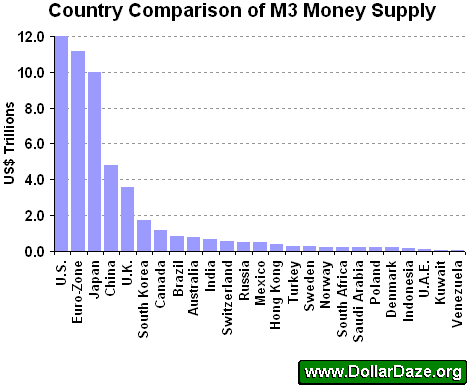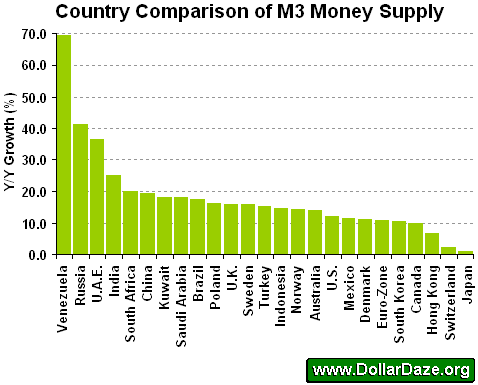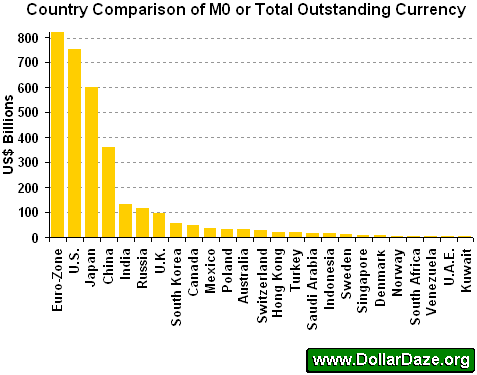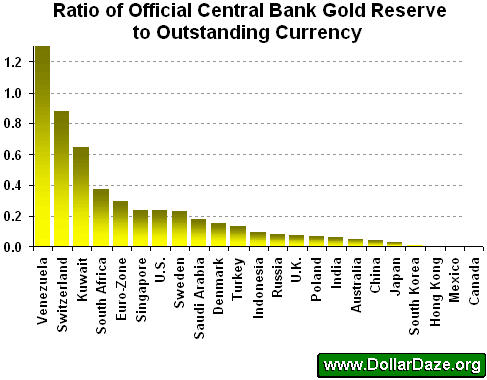Global Money Supply
Economics / Money Supply Jul 31, 2007 - 12:48 PM GMTBy: Mike_Hewitt
This essay makes comparisons between the money supply of 26 selected economic areas and discusses the ratios between the value of official gold reserves to outstanding currency.
For the purposes of this essay, the Euro-Zone includes the thirteen countries that use the Euro currency: Austria, Belgium, Finland, France, Germany, Greece, Ireland, Italy, Luxembourg, the Netherlands, Portugal, Slovenia and Spain. All other economic areas are individual countries.
These 26 economic areas include 38 countries and make up 90.9% of the world's GDP and 64.8% of the world's population .
Monetary Aggregates for Selected Countries
The Bank of International Settlements (BIS) has a link on their webite which lists all of the central banks for different countries . The following charts use money supply data from these official websites. The link to the raw data is at each country's name.
There exists variability in the methodology for calculating different monetary aggregates. This makes cross-country comparisons difficult. Money is defined across a continuum from narrow money that includes highly liquid forms of money (money as a means of exchange) to broad money that covers less liquid forms of money (money as a store of value).
In general terms, M0 refers to outstanding currency (banknotes and coins) in circulation excluding vault cash. M1 is currency plus overnight (demand) deposits plus vault cash. M2 includes the sum of M1 and savings deposits (agreed maturity of up to two years or deposits redeemable at notice of up to three months). M3 is the sum of M2 and repurchase agreements, money market fund shares/units and debt securities up to two years.
Additionally, not every country publishes all four of the common monetary aggregates.
For instance, the Bank of England does not publish official numbers for M1, M2 or M3. For this article, estimates using European Economic and Monetary Union (EMU) aggregates for the U.K. are used. These standards are based on those employed by the European Union.
Some countries, such as the U.S. do not officially publish M0. Where available, figures for outstanding currency in circulation were used. The U.S. Federal Reserve ceased publishing M3 on May 23, 2006 . However, various independent sources have continued to publish U.S. M3 figures and one such source is used here for U.S. M3 money supply.
The money supply levels for each country were converted into U.S. dollars on July 25, 2007 at the displayed exchange rates for ease of comparison. The last column shows the date at which the money supply data is taken from.
| Name of Country | M0 (US$bn) | M1 (US$bn) | M2 (US$bn) | M3 (US$bn) | Exchange (1USD = ) | Date Taken |
| Australia | 33.5 | 182.8 | n/a | 740.2 | 1.1329 AUD | May-07 |
| Brazil | n/a | 84.1 | 355.6 | 783.2 | 1.8695 BRL | Dec-06 |
| Canada | 45.9 | 189.0 | 711.0 | 1052.9 | 1.0430 CAD | May-07 |
| China | 362.4 | 1692.2 | 4818.1 | n/a | 7.5570 CNY | May-07 |
| Denmark | 9.3 | 134.6 | 167.9 | 174.1 | 5.4230 DKK | Apr-07 |
| Euro-Zone | 819.9 | 5165.9 | 9457.1 | 11128.3 | 0.7294 EUR | May-07 |
| Hong Kong | 19.1 | 51.0 | 378.4 | 380.8 | 7.8238 HKD | May-07 |
| India | 127.5 | 233.7 | 234.9 | 592.1 | 40.225 INR | Apr-07 |
| Indonesia | 16.6 | 39.7 | 151.9 | n/a | 9098.0 IDR | May-07 |
| Japan | 598.6 | 3253.6 | 6010.2 | 10021.4 | 120.36 JPY | Jan-07 |
| Korea | 56.7 | 405.6 | 1256.0 | 1681.2 | 915.00 KRW | May-07 |
| Kuwait | 2.7 | 15.3 | 62.2 | n/a | 0.2821 KWD | May-07 |
| Mexico | 37.5 | 94.7 | 448.3 | 465.6 | 10.868 MXN | May-07 |
| Norway | 7.6 | 116.9 | 214.5 | n/a | 5.8098 NOK | Dec-06 |
| Poland | 33.7 | 99.6 | 175.7 | 180.7 | 2.7817 PLN | May-07 |
| Russia | 113.6 | n/a | 419.6 | 466.1 | 25.508 RUB | May-07 |
| Saudi Arabia | 17.6 | 87.9 | 154.3 | 185.1 | 3.7505 SAR | May-07 |
| Singapore | 11.6 | n/a | n/a | n/a | 1.5113 SGD | Mar-07 |
| South Africa | 7.2 | 93.7 | 173.0 | 209.5 | 6.9081 ZAR | May-07 |
| Sweden | 14.5 | 184.2 | 225.5 | 269.9 | 6.7186 SEK | Dec-05 |
| Switzerland | 31.8 | 222.5 | 374.5 | 503.7 | 1.2148 CHF | Jun-07 |
| Turkey | 19.0 | 56.6 | 256.7 | 276.7 | 1.2585 TRY | Dec-06 |
| U.A.E. | 4.8 | 28.4 | 88.2 | 113.1 | 3.6725 AED | Jul-07 |
| U.K. | 96.9 | 1780.0 | 3029.8 | 3532.1 | 0.4876 GBP | Dec-06 |
| U.S. | 756.0 | 1379.0 | 7229.0 | 12000 | 1.0000 USD | Dec-06 |
| Venezuela | 6.0 | 36.6 | 55.8 | 55.8 | 2147.3 VEB | May-07 |
M3 Money Supply for Selected Countries
When considering M3, the total money supply exceeds US$50.1 trillion! Of this amount, the U.S., Euro-Zone and Japan account for US$33.1 trillion or 66.2% of the total. The following graph shows a cross-country comparison for M3.

Please note that the writer was unable to locate official M3 money supply values for China, Indonesia, Norway and Kuwait. For these countries, M2 figures were substituted for M3 in the above figure. As a result, these four countries are underestimated and the actual overall M3 is higher than US$50.1 trillion.
M3 Money Supply Growth for Selected Countries
Of the selected economic areas the annual increase of M3 ranges from 1.0% year over year for Japan to 69.3% for Venezuela! Higher growth rates for money supply do not translate to overall prosperity in the long run. If it did, humanity would have eliminated poverty long ago. Instead, what occurs is an inflationary boom followed by an recession. A hyperinflationary period may occur should confidence in the currency vanish. See a detailed list of failed currencies here .
| Name of Country | M0 (Y/Y%) | M1 (Y/Y%) | M2 (Y/Y%) | M3 (Y/Y%) | Date Taken |
| Australia | 7.3 | 11.9 | n/a | 14.0 | May-07 |
| Brazil | n/a | 20.1 | 11.9 | 17.5 | Dec-06 |
| Canada | 5.5 | 11.7 | 7.7 | 10.2 | May-07 |
| China | 16.7 | 19.8 | 17.3 | 19.2 | May-07 |
| Denmark | n/a | 8.9 | 10.4 | 10.9 | Apr-07 |
| Euro-Zone | n/a | 6.1 | 9.4 | 10.7 | May-07 |
| Hong Kong | 2.3 | 11.2 | 6.8 | 6.8 | May-07 |
| India | 16.9 | 10.5 | 10.4 | 23.9 | Apr-07 |
| Indonesia | 21.5 | 28.1 | 14.9 | n/a | May-07 |
| Japan | 1.3 | (0.5) | 1.5 | 1.0 | Jan-07 |
| Korea | 19.9 | 11.7 | 12.5 | 10.5 | May-07 |
| Kuwait | 3.1 | 13.6 | 18.0 | n/a | May-07 |
| Mexico | 13.7 | 10.2 | 11.4 | 11.5 | May-07 |
| Norway | 2.7 | 22.2 | 14.3 | n/a | Dec-06 |
| Poland | 18.7 | 23.8 | 16.4 | 16.1 | May-07 |
| Russia | 38.1 | n/a | 59.9 | 41.2 | May-07 |
| Saudi Arabia | 5.2 | 11.0 | 18.4 | 17.9 | May-07 |
| Singapore | 7.5 | n/a | n/a | n/a | Mar-07 |
| South Africa | 13.5 | 19.7 | 15.7 | 20.0 | May-07 |
| Sweden | 1.6 | 11.2 | 13.3 | 15.7 | Dec-05 |
| Switzerland | 2.3 | (4.0) | (5.8) | 2.4 | Jun-07 |
| Turkey | 6.2 | 5.8 | 16.8 | 15.2 | Dec-06 |
| U.A.E. | 11.1 | 29.2 | 33.8 | 36.6 | Jul-07 |
| U.K. | 4.5 | 10.5 | 15.6 | 15.8 | Dec-06 |
| U.S. | 1.9 | (0.6) | 6.3 | 12.0 | Dec-06 |
| Venezuela | 44.1 | 83.4 | 69.4 | 69.3 | May-07 |
The overall annual M3 money supply growth for all areas covered in this essay is 10.6%. This is calculated by using the year-over-year M3 growth rate to calculate the total M3 level one year ago for each economic area. The total sum for these calculations arrives at a figure of US$45.3 trillion for one year ago.

M0 Money Supply for Selected Countries
The total for M0 and/or currency in circulation for the above 26 economic areas amounts to US$3.25 trillion. Using the same calculation as for determining overall M3 money supply growth we find that overall M0 and/or total amount of currency is increasing by 8.07% per annum.

The value for the top three currencies in circulation - the USD, Euro and Yen, comprise 66.9% of the total value of all currencies discussed here.
Comparison of Gold Reserves to Currency
According to the World Gold Council , at the end of 2006 the central banks of the 38 countries within these 26 economic areas held 23,938.7 tonnes of gold. This represents 89.0% of the gold held by all countries of the world.
As of July 25, 2007 the closing price for a troy ounce of gold was US$676.00. There are 32,150.75 troy ounces in a metric tonne. Thus, the value of the gold held by the 38 countries is US$520.3 billion. The total value of the currency issued by these countries - US$3.25 trillion - is over six times that figure! This suggests that, for the time being, the value of the official central bank gold reserves equals 15% of the value of their outstanding currency.
The following chart shows a ratio between the value of the official central bank gold reserves to the value of M0 and/or outstanding currency. Norway and United Arab Emirates have no official gold reserves. The 641.7 metric tonnes from the European Central Bank was added to the Euro-Zone, bringing the total for this economic area up to 11,210 metric tonnes as of June 2007. The writer was unable to find M0 money supply figures for Brazil which has a gold reserve of 13.7 metric tonnes.

At the time of writing this article, the official gold reserves of Venezeula appears to out-value all of its outstanding currency by 30%. Given that the year-over-year growth rate of the Venezuelan bolivar for the last 12 months was in excess of 40%, one can expect this ratio to decline signicantly.
Switzerland seems to enjoy both low money supply growth rates along with a high relative value of official gold reserves. These two factors lend strong support to suggesting the Swiss franc as a safehaven currency. Although not as compelling, the Kuwaiti dinar is also worth consideration.
By Mike Hewitt
http://www.dollardaze.org
Mike Hewitt is the editor of www.DollarDaze.org , a website pertaining to commentary on the instability of the global fiat monetary system and investment strategies on mining companies.
Disclaimer: The opinions expressed above are not intended to be taken as investment advice. It is to be taken as opinion only and I encourage you to complete your own due diligence when making an investment decision.
Mike Hewitt Archive |
© 2005-2022 http://www.MarketOracle.co.uk - The Market Oracle is a FREE Daily Financial Markets Analysis & Forecasting online publication.
Comments
|
Loren Howe
08 Apr 08, 19:02 |
Money Supply Data
Thank you so much for compiling this data! It is incredibly helpful and I couldn't find it anywhere else. |



